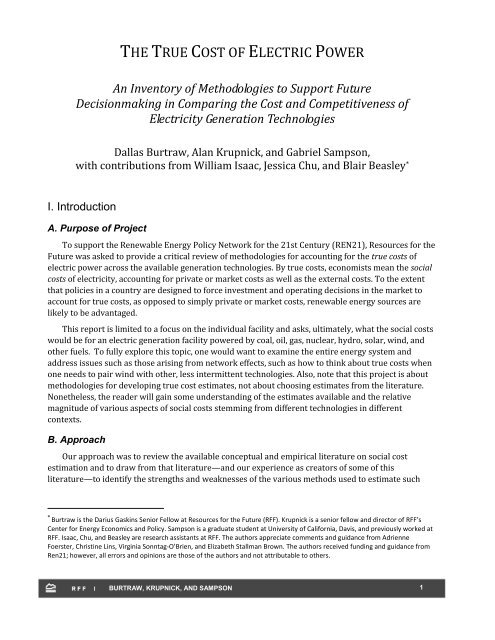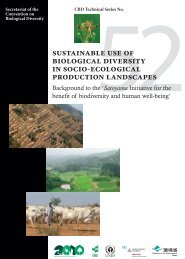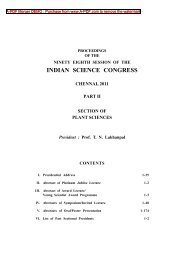The True Cost of Electric Power - India Environment Portal
The True Cost of Electric Power - India Environment Portal
The True Cost of Electric Power - India Environment Portal
You also want an ePaper? Increase the reach of your titles
YUMPU automatically turns print PDFs into web optimized ePapers that Google loves.
THE TRUE COST OF ELECTRIC POWER<br />
An Inventory <strong>of</strong> Methodologies to Support Future<br />
Decisionmaking in Comparing the <strong>Cost</strong> and Competitiveness <strong>of</strong><br />
<strong>Electric</strong>ity Generation Technologies<br />
Dallas Burtraw, Alan Krupnick, and Gabriel Sampson,<br />
with contributions from William Isaac, Jessica Chu, and Blair Beasley *<br />
I. Introduction<br />
A. Purpose <strong>of</strong> Project<br />
To support the Renewable Energy Policy Network for the 21st Century (REN21), Resources for the<br />
Future was asked to provide a critical review <strong>of</strong> methodologies for accounting for the true costs <strong>of</strong><br />
electric power across the available generation technologies. By true costs, economists mean the social<br />
costs <strong>of</strong> electricity, accounting for private or market costs as well as the external costs. To the extent<br />
that policies in a country are designed to force investment and operating decisions in the market to<br />
account for true costs, as opposed to simply private or market costs, renewable energy sources are<br />
likely to be advantaged.<br />
This report is limited to a focus on the individual facility and asks, ultimately, what the social costs<br />
would be for an electric generation facility powered by coal, oil, gas, nuclear, hydro, solar, wind, and<br />
other fuels. To fully explore this topic, one would want to examine the entire energy system and<br />
address issues such as those arising from network effects, such as how to think about true costs when<br />
one needs to pair wind with other, less intermittent technologies. Also, note that this project is about<br />
methodologies for developing true cost estimates, not about choosing estimates from the literature.<br />
Nonetheless, the reader will gain some understanding <strong>of</strong> the estimates available and the relative<br />
magnitude <strong>of</strong> various aspects <strong>of</strong> social costs stemming from different technologies in different<br />
contexts.<br />
B. Approach<br />
Our approach was to review the available conceptual and empirical literature on social cost<br />
estimation and to draw from that literatureand our experience as creators <strong>of</strong> some <strong>of</strong> this<br />
literatureto identify the strengths and weaknesses <strong>of</strong> the various methods used to estimate such<br />
* Burtraw is the Darius Gaskins Senior Fellow at Resources for the Future (RFF). Krupnick is a senior fellow and director <strong>of</strong> <br />
Center for Energy Economics and Policy. Sampson is a graduate student at University <strong>of</strong> California, Davis, and previously worked at<br />
RFF. Isaac, Chu, and Beasley are research assistants at RFF. <strong>The</strong> authors appreciate comments and guidance from Adrienne<br />
Foerster, Christine Lins, Virginia Sonntag- <strong>The</strong> authors received funding and guidance from<br />
Ren21; however, all errors and opinions are those <strong>of</strong> the authors and not attributable to others.<br />
BURTRAW, KRUPNICK, AND SAMPSON<br />
1
















